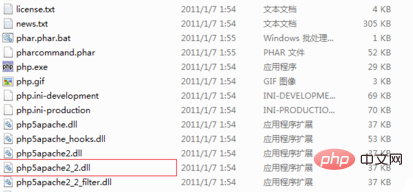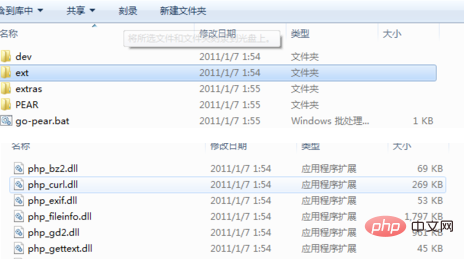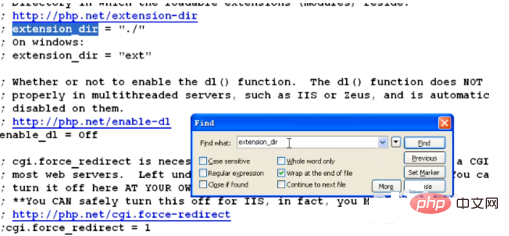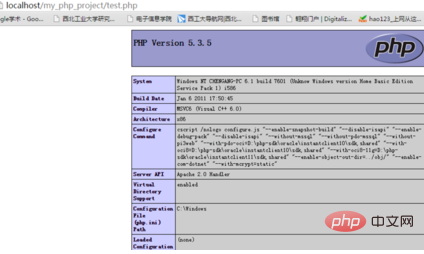How to integrate apache and php together

We know that after installing PHP, apache cannot actually process php files. If we want to integrate php with the apache server, we must modify the configuration file.
(Related recommendations: apache)
The method is as follows:
First add the following code to httpd.conf in the conf directory of apache:
LoadModulephp5_module~php installation path/php5apache2_2.dll
PHPIniDir "~php module installation path"
AddTypeapplication/x-httpd-php.php.phtml

Here I will briefly explain the above code. The whole code means to let apache load the php processing module (LoadModulephp5_module). The "~php installation path" in the code is based on the location where you installed php. Change it depending on the situation. For example, I installed it in the D drive, so my path is: D:\Myenv\php-5.3.5 (note that the slope here is the backslash "\", which needs to be changed in the code. into a forward diagonal bar "/"), the place to add the code is to add it under a lot of LoadModules in httpd.conf, as shown in the following figure:

Then You need to check whether there is this file "php5apache2_2.dll" in the directory you just added. In theory, it should be there. Just in case, you must check it. This file is very important and plays a bridge role.

Next step we need to specify the PHP initialization directory, that is, the code "PHPIniDir '~php module installation path'". This code is used to specify the ini file of php. This file PHP will be configured. In layman's terms, you need to tell apache where to put your PHP. In the same way, we replace the "~php module installation path" in the code with the installation path just now

Then I will explain to you the meaning of the last line of code. "AddTypeapplication/x-httpd-php.php.phtml" means adding an application type. To explain it in vernacular, when it appears *.php file, php will start processing the file. You can add comments to the configuration file to facilitate your own understanding, as shown below:

#So, there are two places where we need to change the path, as shown in the following picture marked in red. Just change the red part to the path where you actually installed PHP (note the forward slope)

In addition, it is also very important to set up the PHP file. Find PHP in your PHP installation directory. .ini-development file and change its suffix to php.ini. The reason for changing this is: our php settings need to be modified in php.ini. As shown below: Just delete the dark blue part of the name.

After the modification, the file will look like this, as shown below:

Now we need to change it in php.ini You can specify the corresponding function module. The specific method is to add the following code "
extension_dir="php extension library path" to the php.ini file you just modified. The purpose of this is to be able to use There are various powerful libraries of PHP, and the "php extension library path" has an "ext" folder under the folder where you installed PHP. Open this folder and it will contain PHP extension libraries. As shown below:

Now let's add the extension library path. Use your notepad to open the "php.ini" file and find the "extension_dir" location. You can use search to quickly locate the location. As shown below :

Then replace the location "extension_dir='ext'" with the path of your php library. Taking mine as an example, my library path is: D:/ Myenv/php-5.3.5/ext (also note the forward slope), as shown below: Replace the blue part with your library path.

The final replacement result is as shown below:

Now our integration has been completed and we can test whether it is successful. Test method: Call a simple php function, the function code is as follows:
<?php
phpinfo();
?>Then restart your apache to see if it can be used.
If you integrate successfully, you will be able to see the shocking effect below.

The above is the detailed content of How to integrate apache and php together. For more information, please follow other related articles on the PHP Chinese website!

Hot AI Tools

Undresser.AI Undress
AI-powered app for creating realistic nude photos

AI Clothes Remover
Online AI tool for removing clothes from photos.

Undress AI Tool
Undress images for free

Clothoff.io
AI clothes remover

AI Hentai Generator
Generate AI Hentai for free.

Hot Article

Hot Tools

Notepad++7.3.1
Easy-to-use and free code editor

SublimeText3 Chinese version
Chinese version, very easy to use

Zend Studio 13.0.1
Powerful PHP integrated development environment

Dreamweaver CS6
Visual web development tools

SublimeText3 Mac version
God-level code editing software (SublimeText3)

Hot Topics
 1382
1382
 52
52
 PHP and Python: Comparing Two Popular Programming Languages
Apr 14, 2025 am 12:13 AM
PHP and Python: Comparing Two Popular Programming Languages
Apr 14, 2025 am 12:13 AM
PHP and Python each have their own advantages, and choose according to project requirements. 1.PHP is suitable for web development, especially for rapid development and maintenance of websites. 2. Python is suitable for data science, machine learning and artificial intelligence, with concise syntax and suitable for beginners.
 PHP's Current Status: A Look at Web Development Trends
Apr 13, 2025 am 12:20 AM
PHP's Current Status: A Look at Web Development Trends
Apr 13, 2025 am 12:20 AM
PHP remains important in modern web development, especially in content management and e-commerce platforms. 1) PHP has a rich ecosystem and strong framework support, such as Laravel and Symfony. 2) Performance optimization can be achieved through OPcache and Nginx. 3) PHP8.0 introduces JIT compiler to improve performance. 4) Cloud-native applications are deployed through Docker and Kubernetes to improve flexibility and scalability.
 PHP: The Foundation of Many Websites
Apr 13, 2025 am 12:07 AM
PHP: The Foundation of Many Websites
Apr 13, 2025 am 12:07 AM
The reasons why PHP is the preferred technology stack for many websites include its ease of use, strong community support, and widespread use. 1) Easy to learn and use, suitable for beginners. 2) Have a huge developer community and rich resources. 3) Widely used in WordPress, Drupal and other platforms. 4) Integrate tightly with web servers to simplify development deployment.
 PHP: A Key Language for Web Development
Apr 13, 2025 am 12:08 AM
PHP: A Key Language for Web Development
Apr 13, 2025 am 12:08 AM
PHP is a scripting language widely used on the server side, especially suitable for web development. 1.PHP can embed HTML, process HTTP requests and responses, and supports a variety of databases. 2.PHP is used to generate dynamic web content, process form data, access databases, etc., with strong community support and open source resources. 3. PHP is an interpreted language, and the execution process includes lexical analysis, grammatical analysis, compilation and execution. 4.PHP can be combined with MySQL for advanced applications such as user registration systems. 5. When debugging PHP, you can use functions such as error_reporting() and var_dump(). 6. Optimize PHP code to use caching mechanisms, optimize database queries and use built-in functions. 7
 How to set the cgi directory in apache
Apr 13, 2025 pm 01:18 PM
How to set the cgi directory in apache
Apr 13, 2025 pm 01:18 PM
To set up a CGI directory in Apache, you need to perform the following steps: Create a CGI directory such as "cgi-bin", and grant Apache write permissions. Add the "ScriptAlias" directive block in the Apache configuration file to map the CGI directory to the "/cgi-bin" URL. Restart Apache.
 PHP vs. Python: Core Features and Functionality
Apr 13, 2025 am 12:16 AM
PHP vs. Python: Core Features and Functionality
Apr 13, 2025 am 12:16 AM
PHP and Python each have their own advantages and are suitable for different scenarios. 1.PHP is suitable for web development and provides built-in web servers and rich function libraries. 2. Python is suitable for data science and machine learning, with concise syntax and a powerful standard library. When choosing, it should be decided based on project requirements.
 How to start apache
Apr 13, 2025 pm 01:06 PM
How to start apache
Apr 13, 2025 pm 01:06 PM
The steps to start Apache are as follows: Install Apache (command: sudo apt-get install apache2 or download it from the official website) Start Apache (Linux: sudo systemctl start apache2; Windows: Right-click the "Apache2.4" service and select "Start") Check whether it has been started (Linux: sudo systemctl status apache2; Windows: Check the status of the "Apache2.4" service in the service manager) Enable boot automatically (optional, Linux: sudo systemctl
 PHP vs. Other Languages: A Comparison
Apr 13, 2025 am 12:19 AM
PHP vs. Other Languages: A Comparison
Apr 13, 2025 am 12:19 AM
PHP is suitable for web development, especially in rapid development and processing dynamic content, but is not good at data science and enterprise-level applications. Compared with Python, PHP has more advantages in web development, but is not as good as Python in the field of data science; compared with Java, PHP performs worse in enterprise-level applications, but is more flexible in web development; compared with JavaScript, PHP is more concise in back-end development, but is not as good as JavaScript in front-end development.




